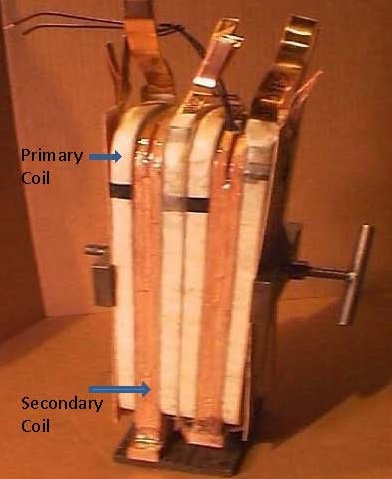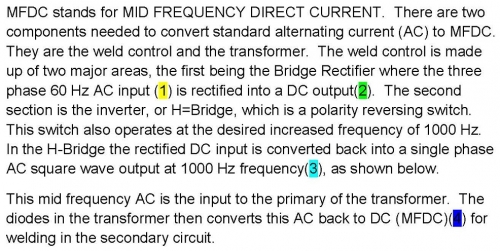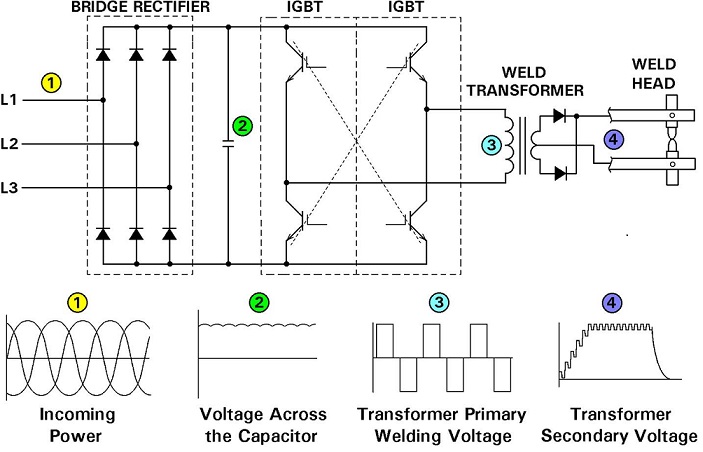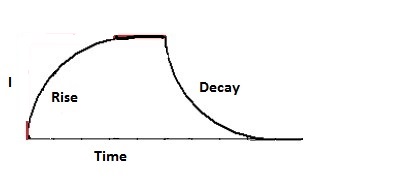
Controls & Transformers
Questions and Answers
The voltages will vary depending upon the machine components and design but commonly at the open electrodes ready to weld the voltage will read about 2 volts. Depending upon the input transformer voltage and the machine this range could be 2 – 5 volts. Many MFDC transformers in the field have 9 or 13 volt outputs. Due to inherent machine resistances this voltage will drop and is frequently measured at 2 volts at the electrodes.
The Resistance Welding Manufacturing Alliance “RWMA” has defined duty cycle in the Resistance Welding Manual, 4th Edition, Section 19-3. It reads “Since resistance welding equipment is used intermittently, the rating is based on a 50 percent duty cycle over a one minute (60 sec) integrating period”. This value was determined long ago and has served the industry well. ISO 5826 also specifies the same 50% duty cycle one minute integration period.
Transformer and machine designers design to a 50% duty cycle. Since most resistance welders operate in the 20% range, equipment has proven to be very robust. Duty cycle is actually a heat rating to protect the insulation in the transformer.
In other industries and specific applications transformers are manufactured at various other duty cycles ranging from 20 – 100%.
For additional information on DUTY CYCLE see the article:

Reference: RWMA – Resistance Welding Manual Section 19.3
ISO - ISO 5826
Resistance welding transformers are manufactured with very little space between windings and between the primary and secondary coils. To provide electrical integrity they must be separated by insulation. This must be maintained throughout the life of the transformer. This insulation is very thin but can last for a very long time if not abused by heat, moisture or physical damage.

TRANSFORMER COILS ASSEMBLED SHOWING PRIMARY & SECONDARY COILS
As transformers age or a machine is being recommissioned the condition of the transformer should be considered. Is it in good shape and ready for another long model run? The question can be evaluated and tested. A transformer manufacturer has the proper test equipment to do this and can evaluate and potentially repair, if necessary.
To calrify this issue attached is a previous article which shows the sequence of changes from the initial three phase 60 Hz AC input through several combinations of frequency and waveform changes to the final MFDC 1000 Hz output.
The ripple in the MFDC plot represents the 1000Hz frequency. The entire MFDC curve is on the positive side of the sine wave. MFDC does have a rise and decay of 3-8 milliseconds before and after full current is reached. This appears in the plot as an upslope or downslope. This should clear up the any questions. AN ARTICLE ON MFDC RISE AND DECAY IS ALSO AVAILABLE.
WHY or HOW DO MFDC CONTROLS CHANGE CURRENT FROM AC TO DC TO AC TO DC?


Schematic of Power Conversion In Control and Transformer of Mid Frequency Inverter
The advantage of MFDC is that the weld current has no zero cross overs so it heats the part quickly. Also, it is DC so there are no inductive power losses or problems with magnetic material in the machine throat.
Generally the plant power requirement is reduced substantially with the 3 phase input. Another advantage is robot payload. Higher frequency in the transformer allows the iron core to be smaller. This is a weight reduction which is significant on the end of a robot arm.
Reference: ENTRON Controls, LLC
In recent years MFDC has become the system of choice for new resistance welding machinery in North America. AC is widely used but for new equipment the preference is MFDC. Automotive and robotic lines use MFDC to take advantage of the weight savings not to mention power reductions and in house primary feed reductions, power factor improvements and others. MFDC does cost more and it is not forgiving if pushed beyond its rated limit.
Its electrical features are excellent in that it heats quickly and does not produce the sine way stitching with the zero cross over cooling. Since it is DC it has virtually no inductance loss when magnetic material enters the throat.
The electrical plot looks as shown below:

PLOT OF MFDC CURRENT
Depending upon the equipment the initial period from initiation of the current till the full current flow is reached takes 3-8 milliseconds (ms) in MFDC. This initial period is called “Rise Time”. When the power is turned off the same curve occurs and is called “Decay Time”.
For additional information about rise time and decay time see the article in this forum:
WHY IS THERE AN INITIAL UPSLOPE IN THE INITIAL CURRENT OF AN MFDC RESISTANCE WELDER?
Reference: RWMA – Resistance Welding Manual 4th Edition
AWS – Welding Journal, Q & A, July 2019
Page 12 of 39
Have a Question?
Do you have a question that is not covered in our knowledgebase? Do you have questions regarding the above article? Click here to ask the professor.
